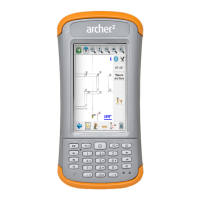
Do you have a question about the Juniper Archer 2 and is the answer not in the manual?
Identifies front and back physical features of the Archer 2 handheld device.
Outlines essential setup steps to perform before first use of the Archer 2.
Explains navigation between the Home screen and Windows Start menu.
Details touch gestures and keypad usage for device navigation and selections.
Describes how to view system details and obtain software updates.
Details the numeric keypad layout, button functions, and shift key operations.
Explains how to customize the P1-P4, camera, and target buttons for specific functions.
Adjusts keypad and display brightness levels to conserve power or improve visibility.
Describes the color display, capacitive touchscreen, and touch gesture recognition.
Configures display orientation and methods for zooming in on screen content.
Sets screen timeout intervals and manages battery power for extended use.
Explains how to disable the touchscreen and procedures for charging the battery pack.
Details battery run time, checking remaining power, and tips for reducing power consumption.
Describes the meaning of the red, green, and blue LEDs on the keypad.
Explains how to use the built-in flashlight feature.
Provides instructions for inserting and removing micro SD cards.
Details the various jacks and connectors on the device's I/O module.
Describes speaker, microphone, and audio jack functions, and how to adjust audio settings.
Explains the role of the Home screen and how to customize its functions and applications.
Covers the status icons in the title bar and the customizable dashboard gadgets.
Lists dashboard gadget functions and their status color meanings.
Describes how to use the favorites bar for quick access to applications.
Explains the function of the tile bar for screen navigation and actions.
Details how to access and navigate the Windows Start menu for applications.
Explains how to activate and use the on-screen keyboard, including different key types.
Guides users through suspending, resetting, and powering off the handheld.
Outlines the process for restoring the Archer 2 to its original factory state.
Describes how to enable subdued lighting for low-light environments.
Explains how to connect the Archer 2 to a computer for synchronization and file transfer.
Guides on creating partnerships for data synchronization between devices.
Introduces the Archer 2's built-in Bluetooth capability and its range.
Steps to establish a wireless connection between the Archer 2 and another Bluetooth device.
Details using the control panel to search for and pair Bluetooth devices.
Configures Bluetooth COM ports for connecting serial devices like GPS receivers.
Instructions for finding and connecting to available Wi-Fi networks.
Displays available networks and guides through network setup and authentication.
Manages Wi-Fi notifications and adjusts network settings.
How to turn on and use the GPS/GNSS receiver to acquire satellite fixes.
Adjusts internal GPS settings and configures external GPS receivers.
Explains the driver that allows multiple programs to access GPS data.
Utilizes the compass gadget for navigation and sets waypoints.
Configures units, sets/clears waypoints, and selects navigation modes.
Logs location points at intervals to create a breadcrumb trail for later use.
Introduces the camera features and Juniper Geotagging for embedding location data.
Configures settings for still images, including flash control.
Details embedding and embossing date, time, and GPS data onto photos.
Adds GPS information and custom notes to image files.
Guides on framing, capturing photos, and accessing post-capture options.
Instructions for recording videos and including audio.
Accesses and manages the stored photos and videos.
Describes the 3G data modem's functionality for WAN connectivity.
Steps for obtaining a data service account and installing the mini SIM card.
Guides on configuring the modem for internet access.
Provides safety guidelines regarding RF interference and modem usage.
Brief instructions on modem maintenance and not disassembling it.
Provides initial steps to scan barcodes using default settings.
Explains the function of the Barcode Connector utility for data input.
Details settings for user preferences, trigger modes, and scan feedback.
Covers testing scanner functionality and general configuration options.
Configures data formats and enables/disables specific 1D barcode symbologies.
Manages settings for composite, postal, and various 2D barcode symbologies.
Covers saving scanner settings profiles and resolving common scanning issues.
Provides guidelines for storing the device and battery for short or long periods.
Instructions for safely cleaning the touchscreen, case, and connectors.
Lists approved cleaners and procedures for recycling the device and batteries.
Details the product warranty coverage and conditions that void it.
Outlines warranty remedies, liability limitations, and services provided.
Information on purchasing extended warranties and the procedure for obtaining repairs.
Explains how to gather and provide system information for repair requests.
Crucial safety warnings regarding battery handling and product usage.
Safety precautions for using the wall charger to prevent injury or damage.
Compliance statements related to FCC rules for digital devices.
Information on RF exposure compliance and CE marking for European Union standards.
Details radio usage restrictions applicable to specific regions like France.
Specifications and safety information for the laser and LED components.
Details key specifications like operating system, processor, memory, and physical features.
Covers display size, resolution, backlight, and touchscreen properties.
Lists specifications for the keypad, battery pack, and connector I/O module.
Details Bluetooth, Wi-Fi, audio capabilities, and LED indicator functions.
Covers operating/storage temperatures, shock resistance, and environmental ratings.
Details standard and optional accessories, and warranty periods.
Lists bundled software and available hardware configurations.
Provides detailed technical specifications for camera and GPS/GNSS modules.
Lists detailed technical specifications for the 3G modem and barcode scanner options.